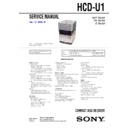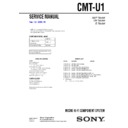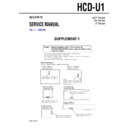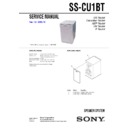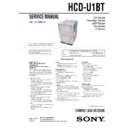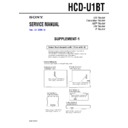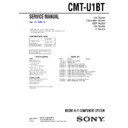Read Sony CMT-U1 / HCD-U1 Service Manual online
SERVICE MANUAL
Sony Corporation
Personal Audio Division
Published by Sony Techno Create Corporation
Published by Sony Techno Create Corporation
AEP Model
UK Model
E Model
COMPACT DISC RECEIVER
9-887-293-03
2006J16-1
© 2006.10
© 2006.10
Ver. 1.2 2006.10
SPECIFICATIONS
HCD-U1
HCD-U1 is the Amplifier, CD player, USB and
Tuner section in CMT-U1.
Tuner section in CMT-U1.
Model Name Using Similar Mechanism
NEW
CD
Base Unit Name
BU-F4BD83S-WOD
Section
Optical Pick-up Name
KSM-215CFP/C2NP
Amplifier section
European model:
European model:
DIN power output (rated): 20 + 20 watts
(6 ohms at 1 kHz, DIN)
Continuous RMS power output (reference):
25 + 25 watts (6 ohms at 1 kHz, 10% THD)
Music power output (reference):
25 + 25 watts (6 ohms at 1 kHz, 10% THD)
(6 ohms at 1 kHz, DIN)
Continuous RMS power output (reference):
25 + 25 watts (6 ohms at 1 kHz, 10% THD)
Music power output (reference):
25 + 25 watts (6 ohms at 1 kHz, 10% THD)
Other models:
DIN power output (rated): 20 + 20 watts
(6 ohms at 1 kHz, DIN)
Continuous RMS power output (reference):
25 + 25 watts (6 ohms at 1 kHz, 10% THD)
(6 ohms at 1 kHz, DIN)
Continuous RMS power output (reference):
25 + 25 watts (6 ohms at 1 kHz, 10% THD)
Inputs:
AUDIO IN (stereo mini jack):
voltage 620 mV, impedance 47 kilohms
voltage 620 mV, impedance 47 kilohms
(USB) port: Type A, maximum current
500 mA
Outputs:
i
(PHONES (stereo mini jack)):
accepts headphones of 8 ohms or more
SPEAKER: accepts impedance of 6 ohms
SPEAKER: accepts impedance of 6 ohms
USB section
Supported bit rate
Supported bit rate
MP3 (MPEG 1 Audio Layer-3):
32 – 320 kbps, VBR
ATRAC: 48 – 352 kbps (ATRAC3 plus),
66/105/132 kbps (ATRAC3)
WMA: 48 – 192 kbps, VBR
AAC: 48 – 320 kbps
32 – 320 kbps, VBR
ATRAC: 48 – 352 kbps (ATRAC3 plus),
66/105/132 kbps (ATRAC3)
WMA: 48 – 192 kbps, VBR
AAC: 48 – 320 kbps
Sampling frequencies
MP3 (MPEG 1 Audio Layer-3):
32/44.1/48 kHz
ATRAC: 44.1 kHz
WMA: 44.1 kHz
AAC: 44.1 kHz
32/44.1/48 kHz
ATRAC: 44.1 kHz
WMA: 44.1 kHz
AAC: 44.1 kHz
CD player section
System: Compact disc and digital audio system
Laser Diode Properties
System: Compact disc and digital audio system
Laser Diode Properties
Emission duration: continuous
Laser Output*: Less than 44.6
Laser Output*: Less than 44.6
µ
W
* This output is the value measurement at a
distance of 200mm from the objective lens
surface on the Optical Pick-up Block with
7mm aperture.
surface on the Optical Pick-up Block with
7mm aperture.
Frequency response: 20 Hz – 20 kHz
Tuner section
FM stereo, FM/AM superheterodyne tuner
FM stereo, FM/AM superheterodyne tuner
FM tuner section:
Tuning range
87.5 – 108.0 MHz (50 kHz step)
Antenna: FM lead antenna
Antenna terminals: 75 ohms unbalanced
Intermediate frequency: 10.7 MHz
Tuning range
87.5 – 108.0 MHz (50 kHz step)
Antenna: FM lead antenna
Antenna terminals: 75 ohms unbalanced
Intermediate frequency: 10.7 MHz
AM tuner section:
Tuning range
European model:
Tuning range
European model:
531 – 1,602 kHz (with 9 kHz tuning interval)
Latin American model:
530 – 1,710 kHz (with 10 kHz tuning
interval)
531 – 1,710 kHz (with 9 kHz tuning interval)
interval)
531 – 1,710 kHz (with 9 kHz tuning interval)
Antenna: AM loop antenna, external antenna
terminal
Intermediate frequency: 450 kHz
General
Power requirements
European model:
Power requirements
European model:
AC 220 – 240 V, 50/60 Hz
Latin American models:
AC 120 – 127 or 220 – 240 V, 50/60 Hz,
Adjustable with voltae selector
Adjustable with voltae selector
Power consumption: 35 watts
Dimensions (w/h/d) (excl. speakers):
Dimensions (w/h/d) (excl. speakers):
Approx. 160
×
241
×
218 mm
Mass (excl. speakers) 3.2 kg
Design and specifications are subject to change
without notice.
without notice.
US and foreign patents licensed from
Dolby Laboratories.
Dolby Laboratories.
2
HCD-U1
TABLE OF CONTENTS
1.
SERVICING NOTES
................................................
3
2.
GENERAL
...................................................................
5
3.
DISASSEMBLY
3-1.
Disassembly Flow ...........................................................
8
3-2.
Back Cover ......................................................................
9
3-3.
Top Panel Assy ................................................................
9
3-4.
Front Panel Assy .............................................................. 10
3-5.
PANEL Board .................................................................. 11
3-6.
SMASTER Board ............................................................ 12
3-7.
SW POWER Board ......................................................... 13
3-8.
Tuner ................................................................................ 14
3-9.
REG Board ...................................................................... 14
3-10. MAIN Board .................................................................... 15
3-11. CD Mechanism Deck (CDM80BT-F4BD83S-WOD) ..... 15
3-12. USB Board, HP Board ..................................................... 16
3-13. SP Board, VOLTAGE SELECTOR Board (E51) ............ 17
3-14. Chassis (TOP) .................................................................. 17
3-15. Lever (Loading R/L) ........................................................ 18
3-16. Disc Stop Lever, Disc Sensor Lever ................................ 19
3-17. DRIVER Board ............................................................... 19
3-18. BD83S Board, Optical Pick-up (KSM-215CFP) ............ 20
3-19. Holder (BU215T) Assy ................................................... 21
3-20. Lever (BU Lock) ............................................................. 21
3-21. Close Lever ...................................................................... 22
3-22. Lever (Dir), Gear (Idl-b) .................................................. 22
3-23. Gear (IDL-C) ................................................................... 23
3-11. CD Mechanism Deck (CDM80BT-F4BD83S-WOD) ..... 15
3-12. USB Board, HP Board ..................................................... 16
3-13. SP Board, VOLTAGE SELECTOR Board (E51) ............ 17
3-14. Chassis (TOP) .................................................................. 17
3-15. Lever (Loading R/L) ........................................................ 18
3-16. Disc Stop Lever, Disc Sensor Lever ................................ 19
3-17. DRIVER Board ............................................................... 19
3-18. BD83S Board, Optical Pick-up (KSM-215CFP) ............ 20
3-19. Holder (BU215T) Assy ................................................... 21
3-20. Lever (BU Lock) ............................................................. 21
3-21. Close Lever ...................................................................... 22
3-22. Lever (Dir), Gear (Idl-b) .................................................. 22
3-23. Gear (IDL-C) ................................................................... 23
4.
TEST MODE
............................................................... 24
5.
ELECTRICAL ADJUSTMENTS
.......................... 25
6.
DIAGRAMS
6-1.
Block Diagram — BD/DRIVER Section — .................. 28
6-2.
Block Diagram — FRONT Section — .......................... 29
SAFETY-RELATED COMPONENT WARNING!!
COMPONENTS IDENTIFIED BY MARK
0
OR DOTTED LINE
WITH MARK
0
ON THE SCHEMATIC DIAGRAMS AND IN
THE PARTS LIST ARE CRITICAL TO SAFE OPERATION.
REPLACE THESE COMPONENTS WITH SONY PARTS WHOSE
PART NUMBERS APPEAR AS SHOWN IN THIS MANUAL OR
IN SUPPLEMENTS PUBLISHED BY SONY.
REPLACE THESE COMPONENTS WITH SONY PARTS WHOSE
PART NUMBERS APPEAR AS SHOWN IN THIS MANUAL OR
IN SUPPLEMENTS PUBLISHED BY SONY.
6-3.
Block Diagram — AUDIO Section — ........................... 30
6-4.
Block Diagram — AMP Section — ............................... 31
6-5.
Block Diagram — POWER Section — .......................... 32
6-6.
Printed Wiring Board — BD83S Section — .................. 33
6-7.
Schematic Diagram — BD83S Section — ..................... 34
6-8.
Printed Wiring Board — DRIVER Section — ............... 35
6-9.
Schematic Diagram — DRIVER Section — ................. 35
6-10. Printed Wiring Board — MAIN Section — ................... 36
6-11. Schematic Diagram — MAIN Section (1/2) — ............. 37
6-12. Schematic Diagram — MAIN Section (2/2) — ............. 38
6-13. Printed Wiring Board — SMASTER Section — ........... 39
6-14. Schematic Diagram — SMASTER Section — .............. 40
6-15. Printed Wiring Board — PANEL Section — ................. 41
6-16. Schematic Diagram — PANEL Section — .................... 42
6-17. Printed Wiring Board — USB Section — ...................... 43
6-18. Schematic Diagram — USB Section — ......................... 44
6-19. Printed Wiring Boards — HP, SP, REG Section — ....... 45
6-20. Schematic Diagram — HP, SP Section — ..................... 46
6-21. Printed Wiring Board — SW POWER Section — ......... 47
6-22. Schematic Diagram — SW POWER Section — ........... 48
6-11. Schematic Diagram — MAIN Section (1/2) — ............. 37
6-12. Schematic Diagram — MAIN Section (2/2) — ............. 38
6-13. Printed Wiring Board — SMASTER Section — ........... 39
6-14. Schematic Diagram — SMASTER Section — .............. 40
6-15. Printed Wiring Board — PANEL Section — ................. 41
6-16. Schematic Diagram — PANEL Section — .................... 42
6-17. Printed Wiring Board — USB Section — ...................... 43
6-18. Schematic Diagram — USB Section — ......................... 44
6-19. Printed Wiring Boards — HP, SP, REG Section — ....... 45
6-20. Schematic Diagram — HP, SP Section — ..................... 46
6-21. Printed Wiring Board — SW POWER Section — ......... 47
6-22. Schematic Diagram — SW POWER Section — ........... 48
7.
EXPLODED VIEWS
7-1.
Overall Section ................................................................ 63
7-2.
Front Panel Section ......................................................... 64
7-3.
AMP Section ................................................................... 65
7-4.
MAIN Section ................................................................. 66
7-5.
CD Mechanism Deck Section-1
(CDM80BT-F4BD83S-WOD) ........................................ 67
(CDM80BT-F4BD83S-WOD) ........................................ 67
7-6.
CD Mechanism Deck Section-2
(CDM80BT-F4BD83S-WOD) ........................................ 68
(CDM80BT-F4BD83S-WOD) ........................................ 68
7-7.
CD Mechanism Deck Section-3
(CDM80BT-F4BD83S-WOD) ........................................ 69
(CDM80BT-F4BD83S-WOD) ........................................ 69
7-8.
Base Unit Section (BU-F4BD83S-WOD) ....................... 70
8.
ELECTRICAL PARTS LIST
.................................. 71
Ver. 1.1
•
Abbreviation
E51 : Chilean and Peruvian models
E51 : Chilean and Peruvian models
3
HCD-U1
Notes on chip component replacement
•
Never reuse a disconnected chip component.
•
Notice that the minus side of a tantalum capacitor may be
damaged by heat.
damaged by heat.
Flexible Circuit Board Repairing
•
Keep the temperature of the soldering iron around 270
°
C
during repairing.
•
Do not touch the soldering iron on the same conductor of the
circuit board (within 3 times).
circuit board (within 3 times).
•
Be careful not to apply force on the conductor when soldering
or unsoldering.
or unsoldering.
CAUTION
Use of controls or adjustments or performance of procedures
other than those specified herein may result in hazardous radiation
exposure.
other than those specified herein may result in hazardous radiation
exposure.
UNLEADED SOLDER
Boards requiring use of unleaded solder are printed with the lead-
free mark (LF) indicating the solder contains no lead.
(Caution: Some printed circuit boards may not come printed with
free mark (LF) indicating the solder contains no lead.
(Caution: Some printed circuit boards may not come printed with
the lead free mark due to their particular size.)
: LEAD FREE MARK
Unleaded solder has the following characteristics.
•
Unleaded solder melts at a temperature about 40
°
C higher
than ordinary solder.
Ordinary soldering irons can be used but the iron tip has to be
applied to the solder joint for a slightly longer time.
Soldering irons using a temperature regulator should be set to
about 350
Ordinary soldering irons can be used but the iron tip has to be
applied to the solder joint for a slightly longer time.
Soldering irons using a temperature regulator should be set to
about 350
°
C.
Caution: The printed pattern (copper foil) may peel away if
the heated tip is applied for too long, so be careful!
•
Strong viscosity
Unleaded solder is more viscou-s (sticky, less prone to flow)
than ordinary solder so use caution not to let solder bridges
occur such as on IC pins, etc.
Unleaded solder is more viscou-s (sticky, less prone to flow)
than ordinary solder so use caution not to let solder bridges
occur such as on IC pins, etc.
•
Usable with ordinary solder
It is best to use only unleaded solder but unleaded solder may
also be added to ordinary solder.
It is best to use only unleaded solder but unleaded solder may
also be added to ordinary solder.
The laser diode in the optical pick-up block may suffer electrostatic
break-down because of the potential difference generated by the
charged electrostatic load, etc. on clothing and the human body.
During repair, pay attention to electrostatic break-down and also
use the procedure in the printed matter which is included in the
repair parts.
The flexible board is easily damaged and should be handled with
care.
break-down because of the potential difference generated by the
charged electrostatic load, etc. on clothing and the human body.
During repair, pay attention to electrostatic break-down and also
use the procedure in the printed matter which is included in the
repair parts.
The flexible board is easily damaged and should be handled with
care.
NOTES ON LASER DIODE EMISSION CHECK
The laser beam on this model is concentrated so as to be focused on
the disc reflective surface by the objective lens in the optical pick-
up block. Therefore, when checking the laser diode emission,
observe from more than 30 cm away from the objective lens.
the disc reflective surface by the objective lens in the optical pick-
up block. Therefore, when checking the laser diode emission,
observe from more than 30 cm away from the objective lens.
SECTION 1
SERVICING NOTES
This appliance is classified as a
CLASS 1 LASER product.
The CLASS 1 LASER PRODUCT
MARKING is located on the rear
exterior.
CLASS 1 LASER product.
The CLASS 1 LASER PRODUCT
MARKING is located on the rear
exterior.
Laser component in this product is capable of emitting radiation
exceeding the limit for Class 1.
exceeding the limit for Class 1.
NOTES ON HANDLING THE OPTICAL PICK-UP
BLOCK OR BASE UNIT
BLOCK OR BASE UNIT
ANTITHEFT LOCK MODE
This mode is used to unable to take sample disc out of disc table in
the shop.
Procedure:
the shop.
Procedure:
1. Press the
@/1
button to turn the power on.
2. Press the
CD
u
button to select “CD”.
3. Press two buttons of
x
CANCEL
and
Z
for 5 seconds.
4. The message “CD LOCKED” is displayed on the fluorescent
indicator tube and the disc slot is locked. (Even if pressing
the
the
Z
button, the message “CD LOCKED” is displayed on
the fluorescent indicator tube and the disc table is locked.)
5. To release from this mode, press two buttons of
x
CANCEL
and
Z
for 5 seconds.
6. The message “CD UNLOCKED” is displayed on the fluores-
cent indicator tube and the disc table is unlocked.
*
Replacement of IC8 used in this set requires a special
tool.
tool.
•
The voltage and waveform of CSP (chip size package) cannot
be measured, because its lead layout is different from that of
conventional IC.
be measured, because its lead layout is different from that of
conventional IC.
•
Lead layouts
Note on USB board replacement
New part of EEP ROM (IC6) on the USB board cannot be used. Therefore,
if the mounted USB board (X-2149-040-1) is replaced, exchange new
if the mounted USB board (X-2149-040-1) is replaced, exchange new
EEP ROM (IC6) with that used before the replacement.
surface
Lead layout of
conventional IC
conventional IC
CSP (chip size package)
MODEL IDENTIFICATION
– Rear Panel –
– Rear Panel –
• Abbreviation
E51 : Chilean and Peruvian models
Parts No.
Model
Part No.
AEP, UK models
2-683-391-0
[]
E51 model
2-683-399-0
[]
Ver. 1.1
4
HCD-U1
CD mechanism deck
(CDM80BT-F4BD83S-WOD)
(CDM80BT-F4BD83S-WOD)
movable block
MAIN board
work stand or
on a spacer
on a spacer
Be sure to place the mechanism deck on a work
stand or on a spacer so that the movable block
does not receive any physical stress.
stand or on a spacer so that the movable block
does not receive any physical stress.
•
SERVICE POSITIONS OF THE MAIN BOARD AND THE CD MECHANISM DECK

